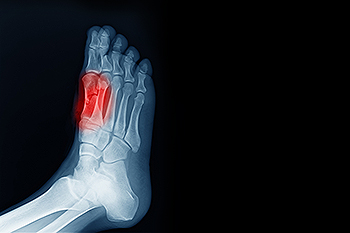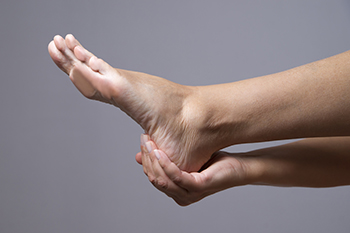Connect With Us
Blog
Items filtered by date: April 2023
Working on the Feet While Pregnant

Due to the nature of their employment, many people across the country must spend the vast majority of the workday standing on their feet. This could potentially pose problems for pregnant women. Specifically, pregnant women who stand for the entire workday may notice poor circulation in their feet, in addition to increased swelling, or edema. If you are a pregnant woman and must stand for long periods of time during the workday, it is wise to consider taking breaks throughout the day to sit down. Perhaps you may consider resting for 15-minute intervals. Keeping yourself hydrated may also be helpful, and it is beneficial to refrain from drinking caffeinated beverages. If you are pregnant and working on your feet, it is suggested that you schedule an appointment with a podiatrist for helpful relief tactics.
While working on the feet, it is important to take the proper care of them. For more information about working on your feet, contact one of our podiatrists from Foot Surgery Specialists of Texas. Our doctors will treat your foot and ankle needs.
Working on Your Feet
Standing on your feet for long periods of time can cause stress and pain in your feet. Your whole body may experience change in terms of posture, back pain, bunions, callouses and or plantar warts. There are ways to avoid these conditions with proper foot care, smart choices and correct posture.
Positive Changes
Negative heeled shoe – Choosing this shoe type places the heel slightly lower than the ball of the foot. These are great for overall foot health. Find shoes that fit you correctly.
Go barefoot – Our feet were not designed to be enclosed for all hours of the day. Try to periodically expose your feet to air.
Eliminate Pain
Foot Exercises – Performing simple exercises, incorporating yoga and doing stretches are beneficial. This will allow increased blood flow to the area and muscles of the foot.
Achilles tendon – Stretching the foot out flat on the floor will relax the calf muscles and tendon. These exercises can be performed almost anywhere. Make sure you add these exercises to your daily regimen.
With a little bit of this information and knowing more about foot health, you will notice changes. Foot stretches and proper footwear will help with pain and prevent further issues.
If you have any questions please feel free to contact our offices located in River Oaks and Sharpstown in Houston, TX . We offer the newest diagnostic and treatment technologies for all your foot and ankle needs.
Toe Fractures in Children

When a child breaks a bone in their toe, it is called a toe fracture. Such a fracture will often result in pain, redness, swelling, and bruising. It might be difficult to bend their toe or put weight on it. If a bone is protruding from the toe or bent at an abnormal angle, immediate medical care should be sought. An X-ray or MRI may be needed to properly diagnose a toe fracture and differentiate it from a possible sprain. If your child has sustained a toe fracture, the buddy taping method or splint may be used to support the toe in its correct position during healing. Buddy taping means taping the broken toe to the toe next to it. A walking boot, hard-soled shoe, or other supportive devices may also help your child move while their toe is undergoing healing. If you think your child may have a broken toe, it is suggested that you visit a podiatrist to have it examined, have necessary tests taken, and obtain treatment.
Broken toes may cause a lot of pain and should be treated as soon as possible. If you have any concerns about your feet, contact one of our podiatrists from Foot Surgery Specialists of Texas. Our doctors will treat your foot and ankle needs.
What Is a Broken Toe?
A broken toe occurs when one or more of the toe bones of the foot are broken after an injury. Injuries such as stubbing your toe or dropping a heavy object on it may cause a toe fracture.
Symptoms of a Broken Toe
- Swelling
- Pain (with/without wearing shoes)
- Stiffness
- Nail Injury
Although the injured toe should be monitored daily, it is especially important to have a podiatrist look at your toe if you have severe symptoms. Some of these symptoms include worsening or new pain that is not relieved with medication, sores, redness, or open wounds near the toe.
If you have any questions, please feel free to contact our offices located in River Oaks and Sharpstown in Houston, TX . We offer the newest diagnostic and treatment technologies for all your foot care needs.
Forefoot Pain

The forefoot is the front part of the foot that contains ligaments, tendons, muscles, nerves, blood vessels, metatarsal bones, and phalanges. The metatarsal bones are the five long bones between the toe bones, the hindfoot, and the midfoot. There are a variety of conditions that can lead to forefoot pain, including Morton’s neuroma, toe pain, and sesamoiditis. The focus here is on sesamoiditis. Most bones are connected to other bones at joints. Sesamoids are bones embedded in muscle and only connected to tendons. On the bottom of the foot, near the big toe, two small sesamoids help with weight bearing and raising the bones of the big toe. Sesamoiditis happens when these tendons become irritated and inflamed. This is common among runners and dancers. If you suffer from pain in your forefoot, it is suggested that you visit a podiatrist to determine the cause of the pain, whether it’s sesamoiditis, and how to treat it best.
Sesamoiditis is an unpleasant foot condition characterized by pain in the balls of the feet. If you think you’re struggling with sesamoiditis, contact one of our podiatrists of Foot Surgery Specialists of Texas. Our doctors will treat your condition thoroughly and effectively.
Sesamoiditis
Sesamoiditis is a condition of the foot that affects the ball of the foot. It is more common in younger people than it is in older people. It can also occur with people who have begun a new exercise program, since their bodies are adjusting to the new physical regimen. Pain may also be caused by the inflammation of tendons surrounding the bones. It is important to seek treatment in its early stages because if you ignore the pain, this condition can lead to more serious problems such as severe irritation and bone fractures.
Causes of Sesamoiditis
- Sudden increase in activity
- Increase in physically strenuous movement without a proper warm up or build up
- Foot structure: those who have smaller, bonier feet or those with a high arch may be more susceptible
Treatment for sesamoiditis is non-invasive and simple. Doctors may recommend a strict rest period where the patient forgoes most physical activity. This will help give the patient time to heal their feet through limited activity. For serious cases, it is best to speak with your doctor to determine a treatment option that will help your specific needs.
If you have any questions please feel free to contact our offices located in River Oaks and Sharpstown in Houston, TX . We offer the newest diagnostic and treatment technologies for all your foot and ankle needs.
Heel Pain Can Be Treated!
What Is a Plantar Fibroma?

A plantar fibroma is a ball of fibrous tissue that develops in the arch of the foot. Though plantar fibromas are benign, they can cause a great deal of pain and interfere with walking and standing. Interestingly, these happen in males more often than females and in middle aged versus older people. When several fibromas develop in the feet, it is called plantar fibromatosis. Pain can worsen as fibromas become larger, from wearing shoes that are too tight, from walking barefoot, or from standing too long. These lumps have no known cause, but may be genetic. They are more common in those of Northern European heritage and less common in Asians. Some experts think trauma and repetitive injuries to the feet may be involved in the development of plantar fibromas. Medical conditions, such as liver disease and diabetes, and lifestyle factors, including alcohol abuse, might also contribute to, but not cause, formation of plantar fibromas. Also, certain medications and supplements are associated with this condition. If you think you have a plantar fibroma, it is suggested that you see a podiatrist for a proper diagnosis and treatment.
A plantar fibroma may disrupt your daily activities. If you have any concerns, contact one of our podiatrists of Foot Surgery Specialists of Texas. Our doctors can provide the care you need to keep you pain-free and on your feet.
Plantar Fibroma
A plantar fibroma is a fibrous knot in the arch of the foot. It is embedded in the plantar fascia which is a band of tissue that extends from the heel to the toes along the bottom of the foot. There can be multiple plantar fibromas in the feet at the same time. There are no known causes for this condition. If you have a plantar fibroma, there will be a bump in the arch of your foot that cannot be missed. Any associated pain is most often due to a shoe rubbing against the nodule. Non-surgical options, such as steroid injections, physical therapy, and orthotics should be tried first. Surgery is a last resort and is the only thing that will remove a plantar fibroma entirely. Consult with a podiatrist for a proper diagnosis and to determine the treatment regimen that is right for you.
What Causes a Plantar Fibroma?
While there are no specific causes identified, a plantar fibroma can possibly come from genetic predisposition or the formation of scar tissue that forms from healing the tears in the plantar fascia.
What Are the Symptoms of a Plantar Fibroma?
There will be a noticeable lump in the arch of the foot that may or may not cause pain. If pain is felt, it is typically because a shoe is rubbing up against the lump or when walking or standing barefoot.
Treatment and Prevention
A plantar fibroma will not disappear without treatment, but it can get smaller and be a non-issue. If pain persists, a podiatrist examines the foot and when the arch of the foot is pressed, pain can be felt down to the toes. An MRI or biopsy might be performed to help diagnose or evaluate the plantar fibroma. The following non-surgical options are generally enough to reduce the size and pain of these nodules:
- Steroid injections
- Orthotics
- Physical therapy to help apply anti-inflammatory creams on the bump
Surgery is considered if the mass increases in size and the patient continues to feel pain after non-surgical methods are tried.
If you have any questions please feel free to contact our offices located in River Oaks and Sharpstown in Houston, TX . We offer the newest diagnostic tools and technology to treat your foot and ankle needs.
Blog Archives
- July 2024
- June 2024
- May 2024
- April 2024
- March 2024
- February 2024
- January 2024
- December 2023
- November 2023
- October 2023
- September 2023
- August 2023
- July 2023
- June 2023
- May 2023
- April 2023
- March 2023
- February 2023
- January 2023
- December 2022
- November 2022
- October 2022
- September 2022
- August 2022
- July 2022
- June 2022
- May 2022
- April 2022
- March 2022
- February 2022
- January 2022
- December 2021
- November 2021
- October 2021
- September 2021
- August 2021
- July 2021
- June 2021
- May 2021
- April 2021
- March 2021
- February 2021
- January 2021
- December 2020
- November 2020
- October 2020
- September 2020
- August 2020
- July 2020
- June 2020
- May 2020
- April 2020
- March 2020
- February 2020
- January 2020
- December 2019
- November 2019
- October 2019

